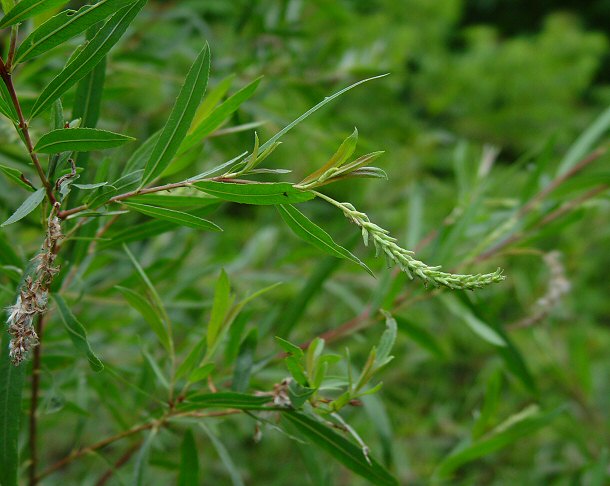Salix interior Rowlee
Sandbar Willow

Native
CC = 3
CW = -3
MOC = 81
© DETenaglia
Salix interior RowleeSandbar Willow | |
 |
Native CC = 3 CW = -3 MOC = 81 |
© DETenaglia |
|
Family - Salicaceae Stems - Multiple from the base, woody, erect to ascending or reclining. A shrub to +5m tall. Twigs glabrous or with a few sparse hairs, terete, with spongy white pith, green or reddish in strong sun. New growth sericeous, green.
Leaves - Alternate, short-petiolate. Petioles to 3mm long, whitish green, glabrous or with some sericeous hairs. Blades linear-oblong, , mostly glabrous above, sericeous or not below, deep shiny green above, dull green below, acute, with unevenly-spaced shallow teeth on the margins (the teeth small and less than 13 per inch).
Inflorescence - (pistillate) - Terminal spike on new season's growth. Spike to +/-4cm long in flower, elongating in fruit to +8cm long. Axis of the inflorescence sericeous to tomentose, light green. Each flower subtended by and partially enclosed by one cupped bract. Bracts enclosing the flowers for about 2/3 of the total flower length. Bracts light green, ovate, sericeous, rounded at the apex, 2-3mm long in flower, -2mm broad. Flowers ascending, tightly overlapping, spiraled around the axis.
Flowers - (pistillate) - Green, sericeous, to +4mm long in flower, longer in fruit. Stigmas 2, each divided and appearing as 4, white in flower, -1mm long, spreading, sessile. Styles wanting. Ovary with many ovules. Staminate flowers not seen. Fruits brown, splitting into 2 halves vertically. Seeds comose. Coma white, like silk, 5-8mm long. Seeds brown, -1mm long, .2mm broad, cylindric.
Flowering - May - June. Habitat - Sand bars, gravel bars, mud flats, streambanks, oxbow lakes, river bottoms, flood plains. Origin - Native to U.S. Other info. - This species of Willow is common throughout nearly all of Missouri except in the bootheel of the state, where it is apparently absent. This species is typically found as a small shrub on gravel bars and mudflats. The plant spreads by underground stems and can form large colonies if left unchecked. Photographs taken along the shores of the Current River, Shannon County, MO., 6-28-04. |